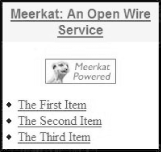2.2 And at the Other End
No one wants to read
raw RSS: the end user will always do
something with a feed before consuming it. For the original use of
RSS, to provide headlines on another site, this means using the RSS
feed as input to an end user's parsing system, which
will transform the RSS into something more readable. For example, the
Meerkat system will transform the following RSS:
<?xml version="1.0"?>
<rss version="0.91">
<channel>
<title>Meerkat: An Open Wire Service</title>
<link>http://meerkat.oreillynet.com/</link>
<description>Meerkat is a Web-based syndicated content reader </description>
<language>en-us</language>
<image>
<title>Meerkat Powered!</title>
<url>http://meerkat.oreillynet.com/icons/meerkat-powered.jpg</url>
<link>http://meerkat.oreillynet.com/</link>
</image>
<item>
<title>The First Item</title>
<link>http://www.oreilly.com/example/001.html</link>
<description>This is the first item.</description>
</item>
<item>
<title>The Second Item</title>
<link>http://www.oreilly.com/example/002.html</link>
<description>This is the second item.</description>
</item>
<item>
<title>The Third Item</title>
<link>http://www.oreilly.com/example/003.html</link>
<description>This is the third item.</description>
</item>
</channel>
</rss>
into the screenshot shown in Figure 2-3.


|
